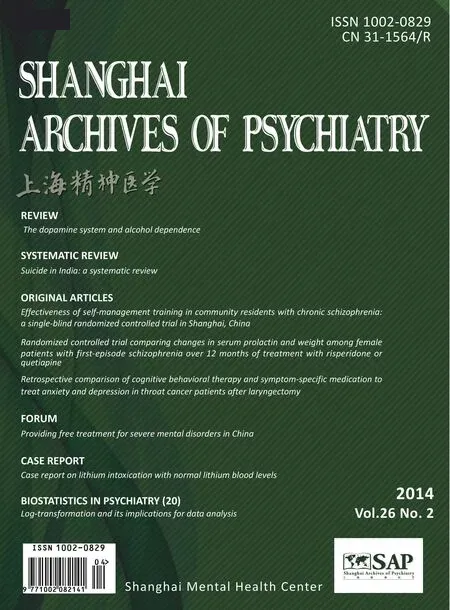Case report on lithium intoxication with normal lithium blood levels
Jing PENG*
•Case report•
Case report on lithium intoxication with normal lithium blood levels
Jing PENG*
lithium intoxication, lithium serum levels, manic episode, adverse reactions, case report
1. Case history
An 18-year old single female of Han ethnicity was admitted to our hospital, a specialized psychiatric hospital, in January 2013 with a one-week history of elevated mood, excessive talking and odd behavior.Her physical examination was normal; she was fully conscious, oriented and able to communicate. However,she talked excessively, had an elevated mood with inflated self-esteem, was irritable, acted bizarrely and had limited insight. Electroencephalogram (EEG), brain CT, and routine blood tests assessing renal function,blood sugar, blood lipid and cardiac enzymes were all normal. Based on ICD-10 criteria, she was diagnosed with a manic episode. She was initially treated with lithium carbonate 250 mg bid which was increased to 500 mg bid five days after admission. On the seventh day of admission, routine blood tests, electrocardiogram(ECG), and physical examination were still normal. On the tenth day of admission the dose of lithium was increased to 750 mg bid. On the 15thday of admission her white blood cell concentration was 11.0X109/L,neutrophil ratio was 0.76, lymphocyte ratio was 0.14,and blood lithium concentration was 0.46 mmol/L. At that time her psychiatric symptoms were under control and she asked to be discharged. She was discharged on lithium 750 mg bid.
Soon after discharge she lost her appetite and began eating irregularly, but her family members did not initially consider this an important enough problem to merit reevaluation. However, her condition deteriorated rapidly so she was brought to the emergency department of a general hospital five days after discharge from our hospital. The general hospital found no cause for her symptoms and transferred her to our hospital. On arrival her face was swollen and she had no urination(anuria). Her vital signs were normal. Her pupil diameter was 4 mm, and her pupillary light reflex was intact. Her heart, lungs, and abdomen did not show any abnormalities, and her liver and spleen were not swollen. Neurological examination found that she was confused and disoriented. She had a flat facial expression, trembling extremities, slurred speech,increased muscle tension and hyperactive tendon reflexes but no sign of meningeal irritation. Her white blood cells concentration was 14.1X109/L, neutrophil ratio was 0.80, lymphocyte ratio was 0.12, and blood lithium was 0.57 mmol/L. Blood tests of liver and renal function were normal. She was diagnosed as lithium carbonate intoxication, so her lithium was stopped and she was administered an intravenous infusion of 250 ml of mannitol. Two hours later, she urinated, and gradually regained consciousness. After 48 hours, her blood lithium concentration was 0.5 mmol/L, she had clear consciousness, her face was less swollen and the 24-hour urinary volume was normal. One week later there was no facial swelling and both physical examination and routine blood test results were back to normal.
2. Discussion
The usual dosage of lithium carbonate, a frequently used mood stabilizer for treating manic episodes,is 500 to 1500 mg/d. By inhibiting the release and increasing the re-uptake of norepinephrine, lithium decreases norepinephrine concentration in the synapses, thus reducing its binding with receptors.Through this mechanism, lithium inhibits manic symptoms and promotes the synthesis of 5-HT.[1]The upper limit of the therapeutic dosage is close to the dosage of possible intoxication. Intoxication results in encephalopathy which can be manifested by depressed consciousness, seizures, coma, shock and eventual kidney failure.[2]To avoid intoxication, blood lithium concentration is closely monitored in patients taking lithium. A blood lithium concentration of 0.8-1.2 mmol/L is considered safe during the acute-phase of treatment, and a concentration of 0.4-0.8 mmol/L is considered appropriate during the maintenance phase of treatment. The maximum effective blood lithium concentration is 1.4 mmol/L,[3]above which intoxication is likely. Blood lithium concentration is the primary measure used to adjust the dosage within the therapeutic range and to limit the risk of intoxication.But some patients can develop lithium intoxication at blood lithium concentrations that are within the therapeutic range.[4]
In this case lithium intoxication occurred at a much lower blood concentration, at the lower end of the therapeutic range. This highlights the need for clinicians to closely monitor the clinical status of patients for early symptoms of intoxication, even when blood levels are in the normal therapeutic range. Clinicians also need to notify patients taking lithium and their co-resident family members about the possibility of lithium intoxication, about the symptoms that indicate intoxication, and about the need to stop the lithium and get rapid medical attention when prodromal symptoms of intoxication such as nausea, poor appetite or vomiting occur. Patients taking lithium or other psychiatric drugs need to be told to inform any other physician in a general medical setting who treats them that they are taking these medications. Physicians in the emergency departments of general hospitals (and in other medical settings) need to routinely ask patients about their use of psychiatric medications, be informed about the adverse effects of these medications, and know how to manage acute intoxication with these medications.Failure to take these common-sense measures can lead to unnecessary risks for patients that could, potentially,be fatal.
Conflict of interest
The author reports no conflict of interest related to this manuscript.
Acknowledgement
The patient reported in this case report provided written informed consent for the publication of this report.
Funding
This case report was not funded.
1. Wang L, Bai L, Li CY. [A case report of intoxication after oral intake of a high dose of lithium carbonate]. Zhongguo Shi Yong Shen Jing Ji Bing Za Zhi. 2011;14(23): 96. Chinese.doi: http://doi.med.wanfangdata.com.cn/10.3969/j.issn.1673-5110.2011.23.058
2. Zhang JQ. [Pocket Guide to Drugs]. Beijing: People’s Health Publishing House; 2006: 42-49. Chinese
3. Shen YC. [Psychiatry, 5thedition]. Beijing: People’s Health Publishing House; 2009. Chinese
4. Liang JH. [A case report of lithium intoxication with normal blood lithium concentration]. Guangzhou Yi Yao. 1997;6:54. Chinese
2014-04-15; accepted: 2014-05-05)

Jing Peng graduated from the Tongji Medical School of Hua Zhong University of Science and Technology in 2006 with a bachelor’s degree in clinical medicine. Since then, she has been working in the Psychology Department of the Xiaogan Rehabilitation Hospital, Hubei Province, where she is currently an attending doctor. Her main research interest is in the diagnosis, treatment, and rehabilitation of schizophrenia.
血锂浓度正常时锂盐中毒的病例报告
彭晶
患者是一名18岁的女性,因首次躁狂发作而入院。给予常规剂量的碳酸锂治疗,两周后她的症状缓解;随即出院,在家服药剂量为250 mg,每天两次。出院五天后,她由于食欲差和意识模糊被送入一家综合医院急诊室。由于综合医院医师无法诊断该问题,患者被转诊送入我院。虽然入院时血锂浓度为0.57 mmol/L(即,治疗量的下限),但是她已经表现出锂盐中毒的症状,包括无尿,四肢震颤、吐词不清、肌张力升高、和腱反射亢进。给予甘露醇静滴,她的急性症状很快得到缓解。此病例说明,无论血锂浓度的高低,对使用锂盐的患者必须监测锂盐中毒的临床症状;同时必须告知患者、家属、和普通医师锂盐中毒的症状和处理。
锂盐中毒,血锂浓度,躁狂发作,副作用,病例报告
Summary:An 18-year old female was admitted to a psychiatric hospital with an initial episode of mania.Treated with routine dosages of lithium bicarbonate, her symptoms resolved after two weeks; she was discharged on a dosage of 750 mg lithium bid. Five days after discharge she was taken to the emergency department of a general hospital with loss of appetite and disturbed consciousness. The general hospital physicians were unable to diagnose the problem so she was transferred back to the psychiatric hospital.At that time she had a lithium blood level of 0.57 mmol/L (i.e., at the lower end of the therapeutic range)but was, nevertheless, clearly experiencing lithium intoxication with anuria, trembling extremities, blurred speech, muscle rigidity and hyperactive tendon reflexes. Treated with intravenous mannitol, her acute symptoms resolved quickly. The case highlights the need to monitor clinical symptoms of intoxication in all patients taking lithium, regardless of their blood level, and to inform patients, family members, and general physicians about the symptoms and management of lithium intoxication.
http://dx.doi.org/10.3969/j.issn.1002-0829.2014.02.008
Xiaogan Rehabilitation Hospital, Xiaogan, Hubei Province, China
*correspondence: 23357902@qq.com
A full-text Chinese translation will be available at www.saponline.org on May 15, 2014.
- 上海精神医学的其它文章
- The dopamine system and alcohol dependence
- Suicide in India: a systematic review
- Effectiveness of self-management training in community residents with chronic schizophrenia: a single-blind randomized controlled trial in Shanghai, China
- Randomized controlled trial comparing changes in serum prolactin and weight among female patients with first-episode schizophrenia over 12 months of treatment with risperidone or quetiapine
- Retrospective comparison of cognitive behavioral therapy and symptom-specific medication to treat anxiety and depression in throat cancer patients after laryngectomy
- Providing free treatment for severe mental disorders in China

